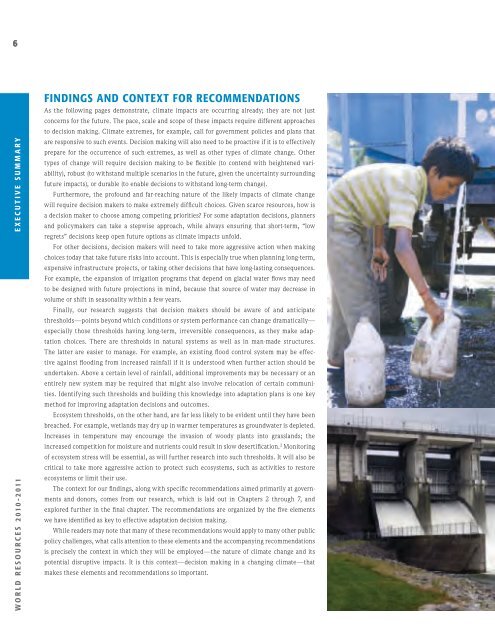Decision Making in a Changing Climate - World Resources Institute
Decision Making in a Changing Climate - World Resources Institute
Decision Making in a Changing Climate - World Resources Institute
- No tags were found...
You also want an ePaper? Increase the reach of your titles
YUMPU automatically turns print PDFs into web optimized ePapers that Google loves.
6<strong>World</strong> <strong>Resources</strong> 2010-2011 executive chapter Summary ?F<strong>in</strong>d<strong>in</strong>gs and Context for RecommendationsAs the follow<strong>in</strong>g pages demonstrate, climate impacts are occurr<strong>in</strong>g already; they are not justconcerns for the future. The pace, scale and scope of these impacts require different approachesto decision mak<strong>in</strong>g. <strong>Climate</strong> extremes, for example, call for government policies and plans thatare responsive to such events. <strong>Decision</strong> mak<strong>in</strong>g will also need to be proactive if it is to effectivelyprepare for the occurrence of such extremes, as well as other types of climate change. Othertypes of change will require decision mak<strong>in</strong>g to be flexible (to contend with heightened variability),robust (to withstand multiple scenarios <strong>in</strong> the future, given the uncerta<strong>in</strong>ty surround<strong>in</strong>gfuture impacts), or durable (to enable decisions to withstand long-term change).Furthermore, the profound and far-reach<strong>in</strong>g nature of the likely impacts of climate changewill require decision makers to make extremely difficult choices. Given scarce resources, how isa decision maker to choose among compet<strong>in</strong>g priorities? For some adaptation decisions, plannersand policymakers can take a stepwise approach, while always ensur<strong>in</strong>g that short-term, “lowregrets” decisions keep open future options as climate impacts unfold.For other decisions, decision makers will need to take more aggressive action when mak<strong>in</strong>gchoices today that take future risks <strong>in</strong>to account. This is especially true when plann<strong>in</strong>g long-term,expensive <strong>in</strong>frastructure projects, or tak<strong>in</strong>g other decisions that have long-last<strong>in</strong>g consequences.For example, the expansion of irrigation programs that depend on glacial water flows may needto be designed with future projections <strong>in</strong> m<strong>in</strong>d, because that source of water may decrease <strong>in</strong>volume or shift <strong>in</strong> seasonality with<strong>in</strong> a few years.F<strong>in</strong>ally, our research suggests that decision makers should be aware of and anticipatethresholds—po<strong>in</strong>ts beyond which conditions or system performance can change dramatically—especially those thresholds hav<strong>in</strong>g long-term, irreversible consequences, as they make adaptationchoices. There are thresholds <strong>in</strong> natural systems as well as <strong>in</strong> man-made structures.The latter are easier to manage. For example, an exist<strong>in</strong>g flood control system may be effectiveaga<strong>in</strong>st flood<strong>in</strong>g from <strong>in</strong>creased ra<strong>in</strong>fall if it is understood when further action should beundertaken. Above a certa<strong>in</strong> level of ra<strong>in</strong>fall, additional improvements may be necessary or anentirely new system may be required that might also <strong>in</strong>volve relocation of certa<strong>in</strong> communities.Identify<strong>in</strong>g such thresholds and build<strong>in</strong>g this knowledge <strong>in</strong>to adaptation plans is one keymethod for improv<strong>in</strong>g adaptation decisions and outcomes.Ecosystem thresholds, on the other hand, are far less likely to be evident until they have beenbreached. For example, wetlands may dry up <strong>in</strong> warmer temperatures as groundwater is depleted.Increases <strong>in</strong> temperature may encourage the <strong>in</strong>vasion of woody plants <strong>in</strong>to grasslands; the<strong>in</strong>creased competition for moisture and nutrients could result <strong>in</strong> slow desertification. 2 Monitor<strong>in</strong>gof ecosystem stress will be essential, as will further research <strong>in</strong>to such thresholds. It will also becritical to take more aggressive action to protect such ecosystems, such as activities to restoreecosystems or limit their use.The context for our f<strong>in</strong>d<strong>in</strong>gs, along with specific recommendations aimed primarily at governmentsand donors, comes from our research, which is laid out <strong>in</strong> Chapters 2 through 7, andexplored further <strong>in</strong> the f<strong>in</strong>al chapter. The recommendations are organized by the five elementswe have identified as key to effective adaptation decision mak<strong>in</strong>g.While readers may note that many of these recommendations would apply to many other publicpolicy challenges, what calls attention to these elements and the accompany<strong>in</strong>g recommendationsis precisely the context <strong>in</strong> which they will be employed—the nature of climate change and itspotential disruptive impacts. It is this context—decision mak<strong>in</strong>g <strong>in</strong> a chang<strong>in</strong>g climate—thatmakes these elements and recommendations so important.
















